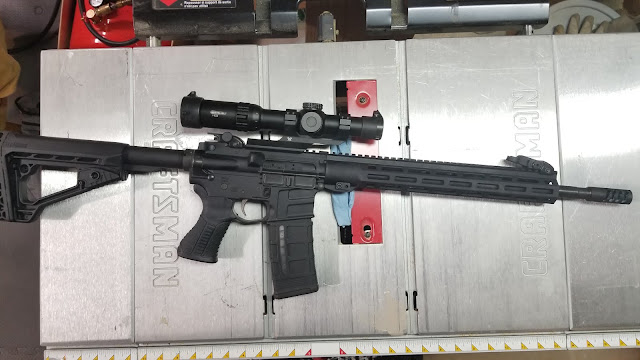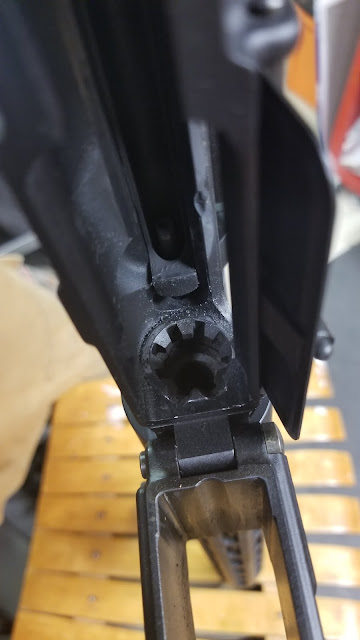The AR-15
Introduction:
There is probably no more recognizable firearm in the United States than the AR-15. Designed by Eugene Stoner in the late 1950's, the AR-15 style of rifles remain the most adaptable, dependable rifles in use by governments and civilians alike. The design of the AR lends itself to light recoil, fantastic ergonomics, and a well-sealed system that is resistant to mud and dirt ingress. The AR-15 style of rifle has seen every caliber and barrel length under the sun, and Stoner's system continues to be a base for firearms innovation and experimentation.
Details:
The AR-15 is a semi-automatic, gas-operated rifle with a multi-lug rotating bolt. The multi-lug bolt has clear advantages over two-lug systems such as the AK-47 or M14. First, multiple lugs allow for a more consistent lockup, since there are more engagement surfaces between bolt and trunnion. This increases overall accuracy and consistency of the rifle.
Second, the multiple lugs allow for a shorter rotational distance that the bolt needs to rotate in order to unlock. This means that there is a shorter overall distance that the bolt carrier has to travel rearward in order to unlock. This gives the potential for manufacturers to have shorter bolt carriers, such as in the AR-18
 |
| AR Bolt and Carrier in the Locked Position |
Now, for this next part, I don't want it to seem like I didn't learn this like a week ago (thanks Forgotten Weapons), but contrary to popular belief, the AR-15 isn't *really* a direct gas-impingement gas system. It's actually a sort of gas piston system. Gas from the gas tube enters an expansion chamber within the bolt carrier, with the rear of the bolt making up the front of the chamber.
 |
| AR Bolt and Carrier in the Unlocked Position |
This gas pressure forces the bolt carrier rearward, camming the bolt open, and then venting the gas out of the two holes in the bolt carrier after the whole system starts traveling backward. Although this creates a very reliable system, it also makes for a very dirty system. Gas is vented all throughout the upper receiver and bolt, so after a range session, AR's get pretty dirty.
AR-15's are interesting in terms of regulation in the United States because none of the pressure-bearing components are regulated. The only regulated part that counts as the "firearm" in the lower receiver. The trunnion on the AR-15 is a barrel extension. This means that all pressure is contained in a very limited portion of the firearm.
Controversy:
No other gun in the United States has penetrated the popular culture like the AR-15. As a result of tragedies such as school shootings, the AR-15 has gone from an element of the gun community, to a political talking point. People that aren't big fans of guns often give attributes to AR's that are either exaggerated, or are only big deals to people outside of the gun community. One of these is the rate of fire of an AR. Political pundits will reference the AR's ability to dispel X number of rounds in Y number of seconds. To anyone who is familiar with firearms, this makes eyes roll. The AR is just another semi-automatic firearm that only fires as fast as the trigger is pulled. Politics also will reference the speed of the bullet that AR's shoot as being optimal to do things like shred flesh and other graphic harm. Although there is some truth to this, the .22 caliber bullet that the AR-15 shoots pales in comparison, in terms of power, to cartridges like the .308 or .30-06, both of which are commonly used.
Conclusion:
In my opinion, the AR-15 and its derivatives represent the current pinnacle of firearms development. Until there is some radical change in weaponry, such as caseless ammunition, I expect that no weapons that are developed will offer any significant advantages over the AR system. Stoner's design has survived the test of time and has gone through decades of iterative development since the 50's. Although there are firearms such as the AK-74 that are just as combat effective, the AR system can't be beat.




Nice article, thanks for sharing!
ReplyDelete